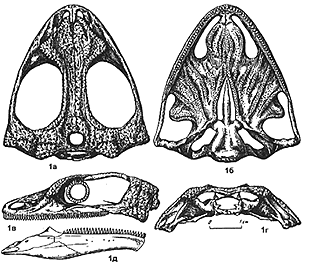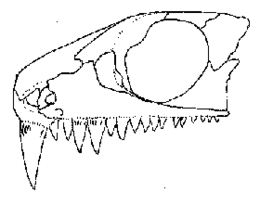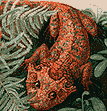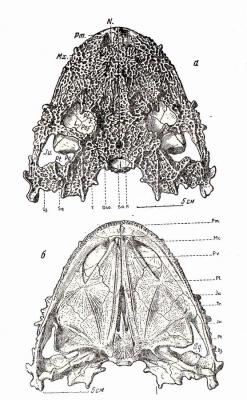
| Palaeos |  |
Anapsida |
| Vertebrates | Lanthanosuchoidea |
| Page Back | Unit Home | Unit Dendrogram | Unit References | Taxon Index | Page Next |
| Unit Back | Vertebrates Home | Vertebrate Dendrograms | Vertebrate References | Glossary | Unit Next |
|
Abreviated Dendrogram
REPTILIOMORPHA |--SYNAPSIDA `--+--EUREPTILIA | ANAPSIDA |--+--Millerettidae | `--Eunotosauridae |--Mesosauridae `--+--Lanthanosuchoidea | |---Acleistorhinidae | | |---Acleistorhinus | | `---Colobomycter | `-Lanthanosuchidae `--+--Bolosauridae `--Procolophonia |--+--Nycteroleteridae | `--Pareiasauridae `--Procolophonoidea |--Owenettidae | `?--TESTUDINES `--Procolophonidae |
Contents
Overview |
 Life reconstruction of Lanthanosuchus watsoni, known from the Isheevo locality (Early Capitanian of Russia). At over a meter in length, this is the largest known representative of the clade Artwork by Nobu Tamura, via Wikipedia, GNU Free Documentation/Creative Commons Attribution Share Alike |
The Lanthanosuchoidea were one of several lines of Permian anapsids, which included several diverse and superficially very disimilar forms. While early forms, known from the Kungurian (latest Early Perman) of Oklahoma, were small or tiny, the very specialised flat-headed Lanthanosuchidae, illustrated above, reached over a meter in length. Like their cousins the Bolosaurs and Nycteroleterids, none of these animals are known to have survived the End-Gaudalupian mass-extinction.
 Procolophonomorpha (= Ankyramorpha sensu deBraga & Rieppel (1997)?)
Procolophonomorpha (= Ankyramorpha sensu deBraga & Rieppel (1997)?)
Range: Mid Permian to recent
Phylogeny: Anapsida : Mesosauridae + (Millerettidae + Eunotosaurus) + * : Lanthanosuchoidea + (Bolosauridae + Procolophonia)
Comments: The Procolophonomorpha are an order or clade of early reptiles that appeared during the Middle Permian. They constitute a diverse assemblage that includes a number of lizard-like forms, such as the Procolophonia and several related groups like the Acleistorhinidae, Lanthanosuchidae, paraphyletic "Nycteroleteridae", and Rhipaeosauridae, as well as the Pareiasaurs. It may or may not also include the Turtles. However Lee 1995, 1996, 1997 argues that turtles evolved from Pareiasaurs but this view is by no means held unanimously. Rieppel & deBraga, 1996 and deBraga & Rieppel, 1997 argue that turtles evolved from Sauropterygians. The traditional view that turtles evolved from unspecified Procolophonids seems to be no longer current. MAK091119
Links: More Nyctiphruretus acudens; Phylogeny and Classification of Amniotes; Introduction to Procolophonoidea
Image: Nyctiphruretus acudens from Mathematics. ATW010213.
Range: Early to Middle Permian of Nth Am and Russia
Phylogeny: Anapsida : Millerettidae + (Procolophonia + (* : Acleistorhinidae + Lanthanosuchidae))
Characters: $ reduction in size of the postparietal, $ long basicranial articulation (ref UCMP)
Links: Paleobiology Data Base - Lanthanosuchoidea
References: deBraga & Reisz 1996
MAK091128
Acleistorhinidae: Acleistorhinus, Colobomycter
Range: Early Permian of Nth Am (Kungurian of Oklahoma)
Phylogeny: Lanthanosuchoidea : Lanthanosuchidae + * (Reisz & Scott 2002)
Characters: $ the largest tooth is located far anteriorly on the maxilla; $ cranial ornamentation consists of sparse and shallow circular dimples. (Wikipedia). Superficailly synapsid-like temporal fenestration. Temporal fenestrata (openings in the cheek area for muscles to strengthen the bite, and perhaps also lighten the skull) are a common feature found in a number of other early anapsids (parareptiles) (Cisneros et al 2004 p.1544)
Comments: With Bolosaurudae the oldest-known anapsid clade.
Links: Wikipedia
References: Cisneros et al 2004 p.1544, Reisz & Scott 2002
MAK091128
Acleistorhinus: A. pteroticus Daly 1969.
Range: Early Permian of Nth Am (Kungurian (Mitchelcreekian LVF of Lucas 2006) of Oklahoma)
Phylogeny: Acleistorhinidae : Acleistorhinus, Colobomycter + *
Size: skull about 3 cm in length
Characters: Synapsid-like lower temporal fenestra
Comments: A tiny but already specialised and probably superfically-lizard-like animal.
Links: Acleistorhinus - UCMP (Best on the Web), Wikipedia, Paleobiology Data Base - Acleistorhinus
References: Daly, 1969.
MAK091128
 Colobomycter: C. pholeter
Vaughn, 1958
Colobomycter: C. pholeter
Vaughn, 1958
Range: Early Permian of Nth Am (Kungurian of Oklahoma)
Phylogeny: Acleistorhinidae : Acleistorhinus + *
Size: skull 7-8 cm in length
Characters: remarkabble for its greatly enlarged, serrated, caniniform teeth, the length of each being greater than half the height of the skull.
Comments: Originally believed to be a pelycosaur. the smallest predatory amniote from its locality (Richard's Spur). The function of the enormous and obviously specilaised canines are unclear.
Links: Wikipedia (Best on the Web), Colobomycter Pholeter - Permian Tetrapods, Paleobiology Data Base - Colobomycter
References: Modesto 1999. Modesto & Reisz 2008, User:Greygirlbeast (Wikipedia)
Graphic: Modesto & Reisz 2008. via Wikipedia
MAK091128
 Lanthanosuchidae: Chalcosaurus, Lanthaniscus, Lanthanosuchus
Lanthanosuchidae: Chalcosaurus, Lanthaniscus, Lanthanosuchus
Range: Middle Permian (Wordian to Capitanian) of Russia

Phylogeny: either Lanthanosuchoidea : Acleistorhinidae + * (Reisz & Scott 2002).; or, Hallucicrania : Pareiasauroidea + *. (Lee 1995, Lee, 1997).
Size: Lanthanosuchus watsoni (illustrated) skull about 20 cm long and wide
Characters: wide, flat skull; lateral temporal fenestra present; dermal sculturing strongly marked
Comments: These strange creatures had extremely flat skulls. So flat in fact that even the jaw muscles could not fit inside, and had to go outside through special openings behind the eyes. The bony tubercles and ridges (a common charcateristic among early anapsids and seymouriamorphs) probably served to strengthened the skull roof. It used to be thought, because of their flat heads, that Lanthanosuchids were aquatic, like temnospondyls, but recent studies have questioned this. Perhaps they subsisted on insects and grubs in forest litter, using the strange head to push under leaves, debris etc. MAK000415.
Links: Introduction to the Lanthanosuchidae; Lanthanosuchus watsoni (Mathematical com); The Journal of Vertebrate Paleontology (abstract: sister clade of Acleistorhinus). ATW030322. Lanthanosuchus - All About Reptiles - makes an intersting hypothesis regarding Lanthanosuchus as a flattened bottom-dweller like a flounder or ray. Also similarity of form with Pelorocephalus. So maybe the Lanthanosuchids were aquatics after all. J. A. Efremov. On the subclass Batrachosauria -- an intermediary group between Amphibians and Reptiles - in Russian, includes detailed drawings of skull. Note: Lanthanosuchus is no longer considered a batrachosaur; Lanthanosuchidae - Wikipedia (in German) MAK091129
Graphic: life reconstruction Mathematical com, drawing of skull from Efremov. (see above link) via Russian Wikipedia link small link large
MAK091129
| Page Back | Unit Home | Page Top | Page Next |
checked ATW040118